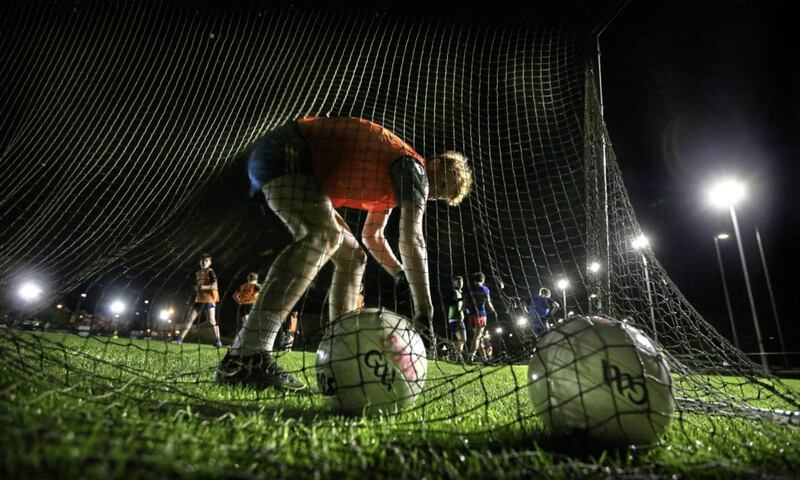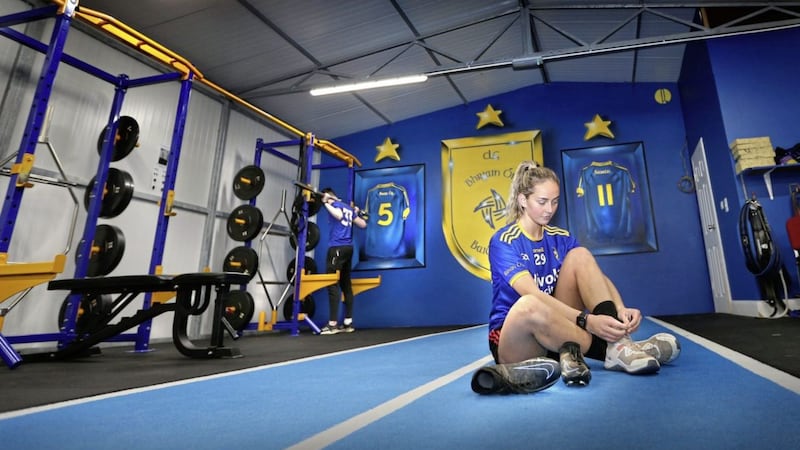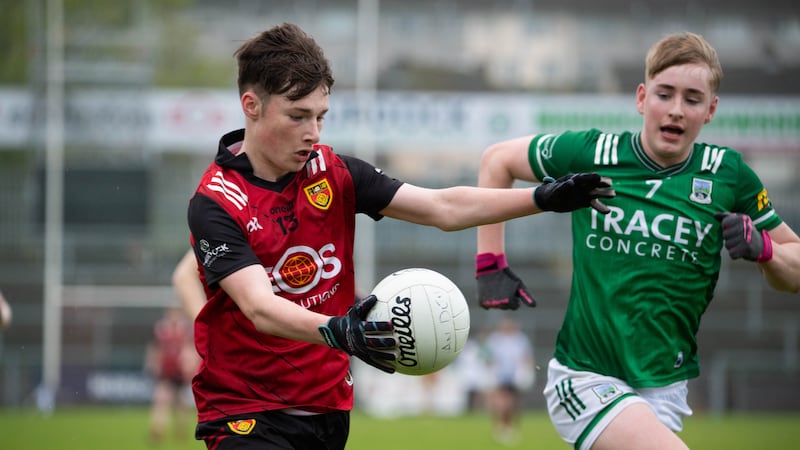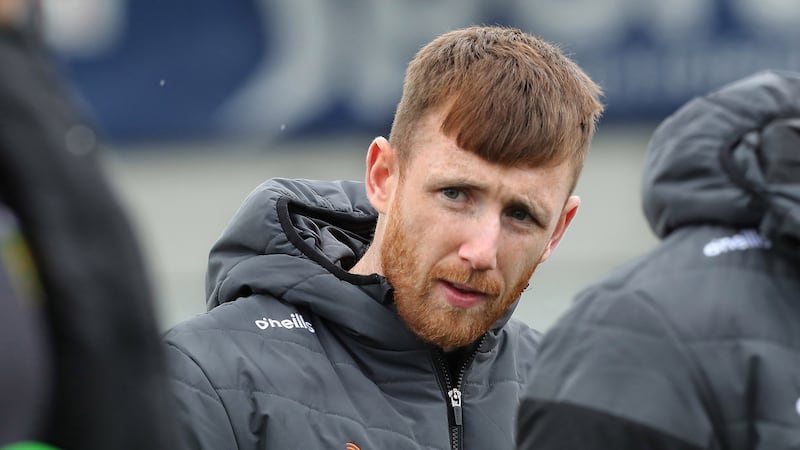JUST after midday tomorrow, Fr John McDevitt will lead the altar servers up the aisle of Steelstown chapel.
The pews of Catholicism have aged and quietened in Derry city as rapidly anywhere else on the island.
But for one lunchtime hour, there will be a sea of young faces sprinkled through a building unfamiliar to most of them the other 51 Sundays of the year.
Brian Óg McKeever was a regular in the chapel every Sunday.
Monday, November 8, will be the 13th anniversary of his death. He would have been 30 earlier this year, a young man with the courage of his convictions.
In many ways he was similar to Brendan Óg Duffy, the Monaghan U20 captain who tragically lost his life in a car accident earlier this year.
Gutsy, talented footballers born with a natural ability to make others follow. Brian Óg was captain of all the Steelstown teams on his way up and Derry’s U16s too.
He would have been wearing five today for the Derry intermediate football championship final, in which his club take on Greenlough.
Instead, there will be no number five. While there are hundreds of Steelstown jerseys around the club that bear it, they haven’t used it in matches since, signifying the hole left in the team and the club.
Brian Óg’s anniversary mass is marked in the calendar of all Steelstown men and women.
A day on which they come together and smile through tears, remembering what he was and grieving once more for what he would have been.
Every time one of their teams hits the field, from U6 Go Games through today’s game, they carry his name and his memory with them.
They are Steelstown Brian Ógs.
Individual games have ceased to be a quest to honour him but to bear his name on their jerseys on a day like today, Brian Óg’s legacy continues to be the mould into which their youth try to fit.
Upstairs, he and Charlene Griffiths will be decked in their blue and gold, but looking down in different directions.
Just over three years after Brian Óg’s death from leukaemia, Charlene passed away after a nine-month battle with cancer.
Described during her requiem mass as “the mother hen” of Steelstown ladies, she was a stalwart of a time when there wasn’t much success or limelight to keep girls there.
At the same time as the men are playing in Ballymaguigan today, the ladies’ team will take on Naomh Bríd in their Ulster semi-final in Belfast.
They hosted and beat Donegal champions St Eunan’s last weekend. Before the game, a lady with the travelling Letterkenny contingent stepped into the clubhouse at Pairc Bhríd, where she saw the image of Charlene and an article on Brian Óg framed on the wall.
“She’s going away knowing their names, knowing that they were important people in the club,” says chairman Eddie Friel. “These are part of Steelstown’s living history. Even though it’s a city club, it has its history, it has its people, and every club is built around its people.
“Brian Óg and Charlene were key individuals, as was Andy Barr, as was Brid Kelly-McElroy and others. They made it happen and we’re carrying on their legacy.”
* * * * *
NEXT year will be Steelstown’s 35th year in existence. In terms of youth, they are second only to Waterside neighbours Doire Trasna.
Former two-time Allstar Anthony McGurk had moved to Derry in the mid-1980s and was one of the club’s founders, along with Drumsurn natives Philip and Marion Devlin, and Claudy’s Mickey Doherty.
The GAA was just beginning to recognise urban potential. The formation of new clubs in cities across Ireland has accelerated since the mid-80s.
When Eddie Friel played his first game for Steelstown, his native Dungiven were just weeks after losing an All-Ireland club semi-final to Corofin.
It was the early weeks of 1998. His brother Stephen had played for them in their maiden year in adult football two years earlier, forming a connection that drew Eddie in when he moved.
Heron Brothers, one of the north’s biggest construction firms, owned a field that they did their training on.
“You were running straight uphill,” he recalls.
City of Derry rugby club were in the process of building a new ground at Judges’ Road, Steelstown were able to avail of their existing facilities for matches.
That land they played their early games on is now home to the Seagate factory, a place that represents the city’s place in a changing world.
Where once there were hundreds of men and women employed in the old sewing factory Fruit of the Loom, in the 20 years since it closed the workforce has gravitated towards the technological. Seagate is one of the north-west’s biggest employers now.
Derry city continues its battle to pull itself up by the bootstraps. It is still home to some of the most deprived areas in Ireland and Britain. Some of them are in Steelstown’s catchment area.
Yet parts of the Culmore Road are more affluent.
Nothing sums up the area’s contrasting demographics than the fact that their St Vincent de Paul collection is the biggest in the city, yet a huge amount of it is redistributed within the parish itself.
“The club has relatively low training fees. One of the things I was very, very keen to ensure was that we’re not putting them up, because we don’t want to be a club that’s exclusive. We shouldn’t be,” says Friel.
“The issues we have to consider when we’re organising programmes are things like can children walk to training because their parents mightn’t have cars.
“The notion that Steelstown is the silver spoon brigade, I don’t think it should be, I don’t think it is.
“While more affluent places like Troy Park and parts of the Culmore Road are in Steelstown parish, the club’s pitch is still in a socially deprived part of Derry – but there’s a lot of Derry that’s deprived.
“I think there is a need for us to do more work to attract more people from where’s close to our ground – Galliagh, Shantallow, Cornshell Fields, places like that. We have been doing it and we’re conscious of it.
“We’re keen to represent the area and represent it well.”
The city’s newest club has brought into focus the unique battles that exist in lands unspoken for.
Steelstown continues to expand and find itself contracted all at once.
The Skeoge Road didn’t exist when the club was formed. One housing estate after the other lines it now, all the way to Donegal.
Ballyarnett has become the area with which they’re most closely associated, while Carnhill, Galliagh and Shantallow are uncontested plains.
Where it gets tricky is in Culmore and Pennyburn, both of which the club traditionally pulled a lot of players from.
A new club has formed in Culmore called the Cuchullains and they’ve taken command of that area.
Steelstown was originally formed as Steelstown/Pennyburn but in stepping in a few years back to solve disputes over whose coaches should have access to which schools, Derry GAA nominated Pennyburn School as Doire Colmcille territory.
Those are densely-populated areas ripe for the picking in the city’s areas that have never enjoyed the same strength of Gaelic identity as of nationalism.
Steelstown are different from their neighbours.
Whereas soccer is the big competitor elsewhere in the city, it is and has been a complete non-issue for Steelstown.
Conán Doherty is a former player living in Dublin. His last game for the club was on the day they were relegated from senior football at the end of 2014.
He came from Shantallow, with its row upon row of council housing packed in. There were players from there and Galliagh but they’re not in huge supply.
The seniors had just lost a junior championship final but won promotion through winning the league title in 2005. The minor team on which he played in ‘06 had to find its hard edge somewhere.
“There would have been the ill-conceived perception that we were middle-class or soft. We were just young,” says Doherty.
“Limavady always used to kick the shit out of us. We had a big turning point against them one night. Kevin Francis popped a ball off and just turned around and lamped somebody.

“Limavady all came in off the bench, we came in off the bench, and you’re standing there trading blows. It’s sad that’s what you have to do but that was the day we stood up to them. We fought back, and we beat them that day. Within ourselves, we shed that thing.
“We started then being proud of where we were from. Paul O’Hea, in our speeches, started talking about being proud of being from the city and not trying to fit in and be like someone else. How if we were going to get respect, we had to own our own identity of being from the city. We weren’t country ones.”
The club’s first 15 years were rapid, best marked by having had a big hand in a minor All-Ireland in 2002, providing Marty Dunne and Paul O’Hea for that team and a MacLarnon Cup winning-side for St Columb’s College the same year.
But it was the club’s own minor team that really made the rest of Derry sit up and take notice.
* * * * *
NOBODY who was at that team’s first meeting with Hugh McGrath will ever forget it.
McGrath was a former Down minor and U21 who was coaching Queen’s in the early 2000s when Steelstown trio Paul O’Hea, Marty Dunne and Aidan Cleary were there.
Cupid’s arrow struck and he was headed the opposite road in 2005, moving to Derry. For the first year he undertook the mad commute from the Foyle Road to his native Saul. Two hours minimum, each way, three times a week.
A year was plenty. O’Hea had badgered him into transferring and that was his connection to Steelstown. At 26, it was primarily about playing, but his footsteps into coaching made set him up for a job too.
Civil war was about to unfold among the minor group that he was asked to step in and take. The club had decided to enter them into the ‘A’ grade. The more senior members of the team felt they were being made into sacrificial lambs for the younger group, who it was felt had the talent to make a real statement and could use the experience.
McGrath didn’t realise what he was walking into. When 17-year-old Tony Ling stood up, he was about to find out.
“We’d just been introduced to Hugh,” laughs Doherty.
“It’s such a legendary moment now but Ling, at 17 years of age, turns around and says to Hugh: ‘No offence, but what are your credentials to take this team?’”
McGrath takes the story up: “Tony Ling tortured me for my credentials, and why I thought a club that I’d never seen before could play ‘A’ grade football,” recalls McGrath.
“I thought ‘a few boys with attitudes about here! This will suit me, because I’ve one as well’. At 17 years of age, him asking ‘who are you?’ O’Hea didn’t tell me that!”
They would beat Magherafelt, Bellaghy and Kilrea en-route to a first ever Minor ‘A’ final.
Their hopes were dashed when Emmett Greene, a huge talent who was making strides in county underage squads, suffered a broken leg in a senior league game just before the decider. Despite a couple of comeback attempts, he never properly played again.
Dungiven beat them by five points, but that team would provide the spine and half the limbs for the team that reached a first intermediate final in 2010, beaten by a point by Castledawson, and then won the club promotion to Division One football the following year.
They lasted three seasons in the senior grade and hacked at a few big trees. Magherafelt were bested in a memorable championship game, but The Loup and Banagher just wriggled free.
Stephen Cleary, the team’s star forward, took up a job with Adidas in Germany and was basically lost from the moment they stepped up. His absence created a vacuum and they haven’t managed to climb back into senior football since.
There were a few years of standing still. McGrath, now back in charge of the senior side, admits there were a few years after Cleary left where they couldn’t get their legs moving again.
It’s all part of the debate over where GAA in Derry city is at, and where it’s going. Last week saw Séan Dolan’s in a junior championship final, while this weekend it’s Steelstown’s turn at intermediate.
Yet Dolan’s won a junior title 12 years ago and this is Steelstown’s fourth final at intermediate, and their third since relegation back out of the senior grade. They are still the only intermediate club in the city, with the rest in junior.
“The way you’ve laid it out, is it progressing? Clearly not, otherwise we’d have at least one senior club and the rest in intermediate,” admits McGrath.
“Until we [the city] have a club at senior level, competing consistently, I don’t think you can call what we currently have progress.”
There are a myriad of factors, one being that when their lads hit university age, they’ve spent 18 years in their home city and want to see the world.
When Hugh McGrath was still playing his own football, the ladies’ team had no manager and he stepped into the breach. They kept it afloat for a year when it was right up against the wall.
This afternoon they’re looking to force their way into an Ulster intermediate final, having won three of the last five Derry senior titles.
“Charlene was very similar to Brian Óg, an attitude that she’d never be beat,” says McGrath.
“Girls’ football was just in its infancy, it wasn’t as desirable or glamourous as it is now, especially around our club where they’re winning titles now.
“She was always there, a real driving force to keep the thing going and great with the young players coming through.”
It wasn’t just that Brian Óg McKeever and Charlene Griffiths played for the club. It was the way they played.
Brian Óg made his senior debut at 17, weeks before he was diagnosed with leukaemia. He marked 1993 All-Ireland winner Richard Ferris and threw himself in head first.
“I had him playing for me as a 14-year-old on that minor team,” says McGrath.
“He was a pleasure to coach, a pleasure to play with for a short period of time, and a pleasure to know.
“Anyone that knew Brian Óg would tell you he was no shrinking violet. He was front and centre of anything he did.
“Most 14-year-olds at minor training would be quiet and fade into the background – definitely not with this character. He loved having a rattle at Emmett Greene and Kevin Francis. I remember Mickey McKinney getting a few lashings from Brian Óg in good times.
“Even through his sickness, you never felt he was sick. He had a mass at the club before his passing but even then… He had his head shaved, but he had his head shaved most of the time. He was still full of craic and full of life.
“That’s what made his passing so much more difficult. You just didn’t feel it, you didn’t see it.
“You knew he was sick, you knew the day was going to come at some stage, but the character he was, he was just so strong. As a player, you never felt any weakness coming from him.”
Steelstown lost their first two intermediate finals by a point. Last year, Greenlough had four to spare but only after a late surge.
“I’ve said to some of the players, every day that passes is a day closer to Steelstown winning a championship,” says Eddie Friel. “We don’t know if we’re five days away or 526 days away, but we’re getting closer every time.
“But there would be a lovely symmetry to it if we were to win it this weekend.”








